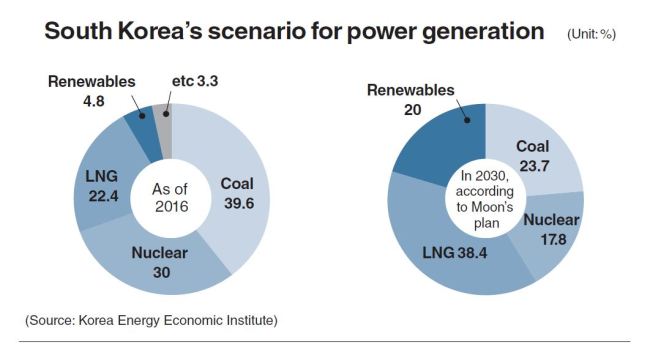The nuclear-free policies laid out by President Moon Jae-in as he attended the shutdown of the country’s oldest nuclear reactor on Monday have been hailed by most citizens so far, but they are also expected to bring a major change in the nation’s energy generation portfolio entailed with technical challenges and price hikes, experts in Seoul said Friday.
Theoretically, renewables and liquefied natural gas can replace nuclear power, but the government can face difficulties with keeping the nation’s electricity reserve ratio at a stable level. Noncombustion energy sources -- wind and solar power -- come with problems. They are not reliable, causing problems of power intermittence.
“Generation facilities using renewables usually produce some 20 percent of their nominal capacities, as often there are power intermittence,” said a researcher from the Korea Energy Economic Institute. This means that it requires five times more facilities to meet the target amount of the generation, he said.
Others have suggested energy storage system as a key to solving such a dilemma. But it costs a lot, and is not able to handle power distribution on a large scale, they added.
To go full-fledged toward the path of alternative energy, considerations of the economic burden thus must accompany.
“It could be difficult to expand generating facilities using renewable sources to account for 20 percent by 2030,” said Joo Han-gyu, a nuclear engineering professor at Seoul National University.
“Making renewables to account for 20 percent of the nation’s total generation would cost some 170 trillion won of budget,” he added. Building eight nuclear power plants, as planned in the 7th Basic Plan for Long-term Electricity Supply and Demand, would have cost some 20 to 30 trillion won.
For South Korea with scarce land occupied by a population of over 50 million, turning to renewables may come with the hard choice as alternative energy plants with solar panels and wind turbines require a lot of land, experts added.
Under Moon’s plan, LNG will become the top energy source for electricity generation in the next 13 years, replacing the nation’s high dependency on coal and nuclear which accounted for nearly 70 percent as of last year.
By 2030, renewables that currently cover less than 5 percent are set to generate 20 percent of power needed to run Asia’s fourth-largest economy.
The dependency on nuclear power is set to be lowered to 18 percent from 30.7 percent in 2016.
Such a change will also come with a more expensive electricity bill.
Under Moon’s nuclear-free drive, the overall cost of generating electricity is expected to increase by 11.6 trillion won, up 21 percent from the cost spent in 2016, according to a recent study by the state-run think tank Korea Energy Economics Institute.
The report also said that the nation’s gross domestic product is forecast to decrease by 0.93 percent, while the product price will gain 1.16 percent if electricity cost increases by 20 percent.
Amid mixed hopes and concerns toward Moon’s nuclear free policy, the key is to prepare detailed plans that go beyond goals. Moon has pledged that the government won’t approve previous plans to extend the lifespan of nuclear reactors and scrap plans to build more reactors by previous administrations.
“The administration has not laid out specific instructions yet, especially regarding the constructions of Shin-Kori No. 5 and 6. For the moment, KHNP will continue constructing Shin-Kori nuclear power plants and wait for the government to make further guidelines,“ said the KHNP‘s official.
“The company will follow the administration’s decision,” it added.
The Ministry of Trade, Industry and Energy said it would lay out the latest update on the state plan for long-term electricity supply and demand later this year.
“Many things are uncertain at this moment, and it is a little early to talk about specifics,” an official said.
Despite lingering concerns, Moon‘s environment-friendly energy policy came at a right timing and that the nation is ready for such shift.
“The shift will gradually take place and the country will be able to resist from the impact that comes from shutting down nuclear facilities,” said Yoo Seung-hoon, an energy policy professor at Seoul National University of Science and Technology.
Many countries in the world are reaching grid-parity, meaning that generating electricity using alternative sources like solar and wind, costs more or less similar to the traditional sources like nuclear power and fossil fuels. Renewables will have better footing in the market to compete with other energy sources in the future, he explained.
“The nation‘s LNG facilities’ operating ratio is currently some 40 percent, which means that generation shortfall is unlikely to happen,” he added.
The percentage of power generation by renewables has risen 2-3 percent less than three years, Lee Sang-hoon, director of Green Energy Institute said adding that the actual cost of expanding environment-friendly power generation facilities will be a lot lower what pro-nuclear power experts estimated.
“Let’s say we are to build facilities to secure 32 gigawatt, it will cost approximately 40 trillion won, not 170 trillion won.”
By Shim Woo-hyun (ws@heraldcorp.com)

![[AtoZ into Korean mind] Humor in Korea: Navigating the line between what's funny and not](http://res.heraldm.com/phpwas/restmb_idxmake.php?idx=645&simg=/content/image/2024/04/22/20240422050642_0.jpg&u=)


![[Herald Interview] Why Toss invited hackers to penetrate its system](http://res.heraldm.com/phpwas/restmb_idxmake.php?idx=645&simg=/content/image/2024/04/22/20240422050569_0.jpg&u=20240422150649)
![[Exclusive] Korean military set to ban iPhones over 'security' concerns](http://res.heraldm.com/phpwas/restmb_idxmake.php?idx=645&simg=/content/image/2024/04/23/20240423050599_0.jpg&u=20240423183955)
![[Graphic News] 77% of young Koreans still financially dependent](http://res.heraldm.com/phpwas/restmb_idxmake.php?idx=645&simg=/content/image/2024/04/22/20240422050762_0.gif&u=)